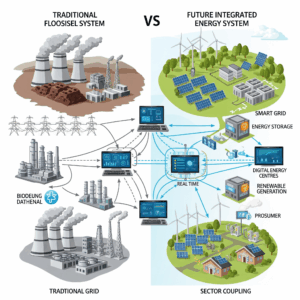The global energy crisis and climate challenge demand that we rethink how we design an energy system. Transitioning from fossil fuels to renewables, smart grids, and storage assurance is essential. This guide highlights key strategies and technologies to build a future-ready energies that supports sustainability, reliability, and decarbonization.
1. What Is an Energy System?
An energy system encompasses generation, storage, transmission, and distribution of power. A future sustainable energy integrates solar, wind, geothermal, nuclear, and other low‑carbon sources to minimize greenhouse gas emissions .
2. Renewable Energy Generation as the Backbone
Future energy systems must prioritize solar PV, wind turbines, hydropower, and geothermal––clean sources that deliver low‑carbon electricity. Advances in solar cell efficiency and wind turbine design are driving down costs and enhancing output .
3. Energy Storage: Essential for Grid Stability
Intermittent generation from renewables makes energy storage critical to any future energy. Technologies like lithium-ion batteries, flow batteries, pumped hydro, compressed air, and hydrogen storage ensure consistent supply and prevent curtailment .
4. Smart Grid Integration
Transforming the grid into a smart grid enables real-time control, two-way flows, demand management, and integration of distributed energy resources. A digital backbone is vital for optimizing the future energy .
5. Power‑to‑X for Sector Coupling
Energies flexibility improves through Power‑to‑X: converting surplus renewable electricity into hydrogen, synthetic fuels, or chemicals. This facilitates decarbonization across transport and industry .
6. Hybrid Power and Diverse Generation Mix
A resilient future energy systems often uses hybrid power solutions—combinations of solar, wind, battery, and backup generation—in storage‑balanced microgrids or community energy systems.
7. Emerging Technologies: AI, Blockchain & Diagnostics
AI and blockchain are enabling advanced operations in the system through predictive maintenance, decentralized energy markets, and real-time optimization. Prosumers (producer‑consumers) become active players in smart grid management.
8. Policy, Regulation & Finance
Supporting infrastructure and investments hinge on strong policy frameworks. Carbon pricing, renewable targets, incentives, and innovation funding are key to mobilizing capital for a sustainable energy systems .
9. Community‑Scale Energy Systems
Localized energy communities build decentralized future energy systems where generation, storage, and consumption are optimized at community scale. These systems boost resilience and social participation .
10. Roadmap: From Fossil to Future
To build a future energy systems, the roadmap includes:
-
Scaling renewables and low‑carbon generation
-
Deploying energy storage and smart grid tech
-
Leveraging Power-to-X and sector coupling
-
Fostering hybrid power microgrids and community systems
-
Innovating with AI, blockchain, and digital platforms
-
Advocating robust policy, regulation, and finance alignment
Vision & Benefits
A well-designed future energy systems delivers cleaner air, climate resilience, energy security, reduced fossil reliance, and inclusive economic growth. It enables a global shift to low‑carbon electricity systems and positions societies to adapt to future energy demands sustainably.
Stay informed on transforming energies systems for impact—follow IMPAAKT, your top business magazine, for strategic insights and sustainability-driven news.












